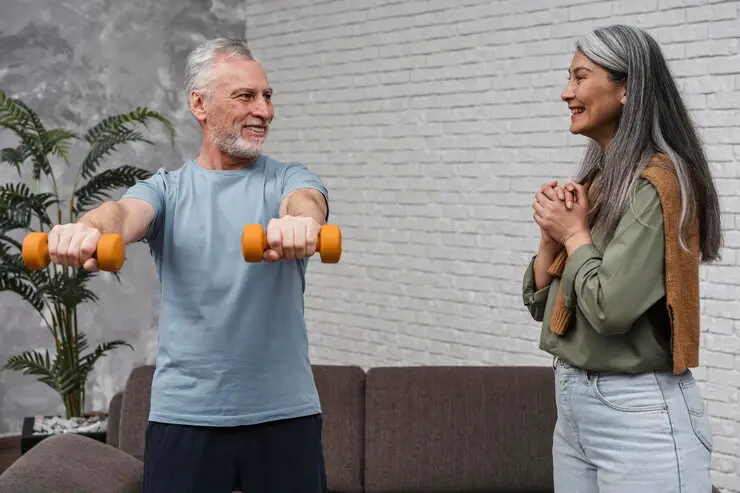As we age, maintaining physical health becomes increasingly important. While much attention is often given to cardiovascular health and lower body strength, the significance of shoulder workouts for older adults is frequently overlooked. Shoulders are vital for a wide range of daily activities, from lifting groceries to reaching for objects on a shelf. Maintaining strong and flexible shoulders can significantly enhance the quality of life for older individuals, helping them stay independent and active.
Why Shoulder Health Declines with Age
Understanding why shoulder health tends to decline with age is crucial in appreciating the importance of shoulder workouts. Several factors contribute to this decline:
Muscle Atrophy: As we age, muscle mass naturally decreases in a process known as sarcopenia. This reduction in muscle mass affects strength and endurance, making it harder to perform tasks that once seemed effortless.
Joint Degeneration: The shoulder joint, like all joints in the body, can suffer from wear and tear over the years. This can lead to conditions such as osteoarthritis, where the cartilage that cushions the joints wears down, causing pain and stiffness.
Reduced Flexibility: Aging also brings about a decrease in the elasticity of muscles and tendons, leading to reduced range of motion. This can make movements that involve lifting or reaching more challenging and sometimes painful.
Postural Changes: Over time, poor posture can lead to imbalances in the shoulder muscles. For example, many older adults develop a forward-head posture, which places extra strain on the shoulders and upper back.
Benefits of Shoulder Workouts for Older Adults
Engaging in regular shoulder workouts can counteract many of the negative effects of aging on shoulder health. Here are some key benefits:
1. Improved Strength and Functionality
Strengthening the shoulder muscles enhances overall upper body strength, making it easier to perform daily activities. Strong shoulders contribute to better posture and help prevent injuries by providing stability to the shoulder joint.
2. Enhanced Flexibility and Range of Motion
Regular shoulder exercises can improve flexibility and range of motion, making it easier to reach for objects, perform overhead movements, and maintain independence in daily tasks.
3. Pain Reduction
Strengthening the muscles around the shoulder joint can alleviate pain by reducing the strain on the joint itself. Exercises that promote proper posture and alignment can also help mitigate chronic pain conditions.
4. Better Posture
Strong shoulder muscles support proper alignment of the spine and reduce the tendency to slump or hunch forward. Improved posture not only reduces the risk of musculoskeletal issues but also contributes to a more youthful appearance and increased confidence.
5. Prevention of Injuries
Regular shoulder workouts can help prevent injuries by improving muscle balance and joint stability. This is particularly important for older adults, who may be more susceptible to falls and other accidents.
Key Shoulder Exercises for Older Adults
It’s important to choose exercises that are safe and effective for older adults, focusing on both strength and flexibility. Here are some key shoulder exercises:
1. Shoulder Press
The shoulder press is an excellent exercise for building strength in the shoulder muscles. It can be performed with dumbbells or resistance bands.
- How to Do It:
- Sit or stand with feet shoulder-width apart.
- Hold a dumbbell in each hand at shoulder height, palms facing forward.
- Press the dumbbells overhead until your arms are fully extended.
- Lower the weights back to shoulder height and repeat.
2. Lateral Raises
Lateral raises target the deltoid muscles, which are crucial for shoulder strength and stability.
- How to Do It:
- Stand with feet shoulder-width apart, holding a dumbbell in each hand at your sides.
- With a slight bend in your elbows, lift the dumbbells out to the sides until they reach shoulder height.
- Slowly lower the weights back to your sides and repeat.
3. Front Raises
Front raises strengthen the anterior deltoid muscles, important for lifting movements.
- How to Do It:
- Stand with feet shoulder-width apart, holding a dumbbell in each hand at your sides.
- Lift the dumbbells in front of you to shoulder height, keeping your arms straight but not locked.
- Lower the weights back to your sides and repeat.
4. External Rotations
This exercise targets the rotator cuff muscles, which are crucial for shoulder stability.
- How to Do It:
- Attach a resistance band to a stable object at waist height.
- Hold the band with your elbow bent at a 90-degree angle and your upper arm close to your body.
- Rotate your arm outward, away from your body, keeping your elbow fixed.
- Slowly return to the starting position and repeat.
5. Wall Angels
Wall angels help improve shoulder mobility and posture.
- How to Do It:
- Stand with your back against a wall, feet a few inches away from the wall.
- Raise your arms to form a “W” shape, with elbows bent and back of the hands against the wall.
- Slowly slide your arms up the wall to form a “Y” shape, then return to the “W” position.
- Repeat the movement, keeping your back and arms in contact with the wall.
Incorporating Shoulder Workouts into a Routine
To reap the benefits of shoulder workouts, it’s essential to incorporate them into a regular fitness routine. Here’s how to do it:
1. Set Realistic Goals
Start by setting achievable goals based on your current fitness level and gradually increase the intensity and duration of your workouts.
2. Mix It Up
Include a variety of exercises in your routine to target different muscle groups and prevent boredom. Mixing up your workouts can also reduce the risk of overuse injuries.
3. Schedule Workouts
Plan your workouts into your weekly schedule, just like any other important appointment. Consistency is key to seeing results.
4. Combine with Other Activities
Shoulder workouts can be combined with other forms of exercise, such as walking, swimming, or yoga, to create a well-rounded fitness routine.
To conclusion on this topic, Shoulder workouts are vital for older adults to maintain strength, flexibility, and overall quality of life. By incorporating regular shoulder exercises into a fitness routine, older individuals can enjoy numerous benefits, including improved posture, reduced pain, and enhanced ability to perform daily tasks. As with any exercise program, it’s essential to start slowly, use proper form, and listen to your body to prevent injuries. With consistent effort, shoulder workouts can help older adults stay active, independent, and healthy for years to come.



Very interesting platform 😘😘